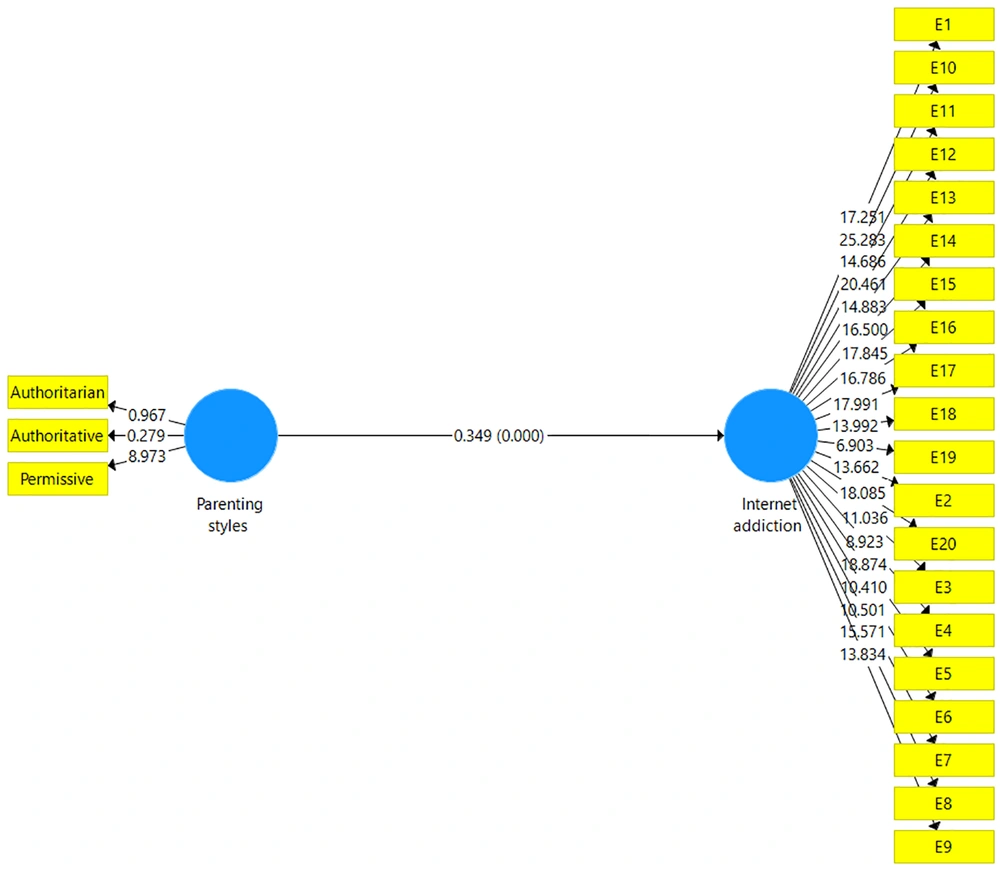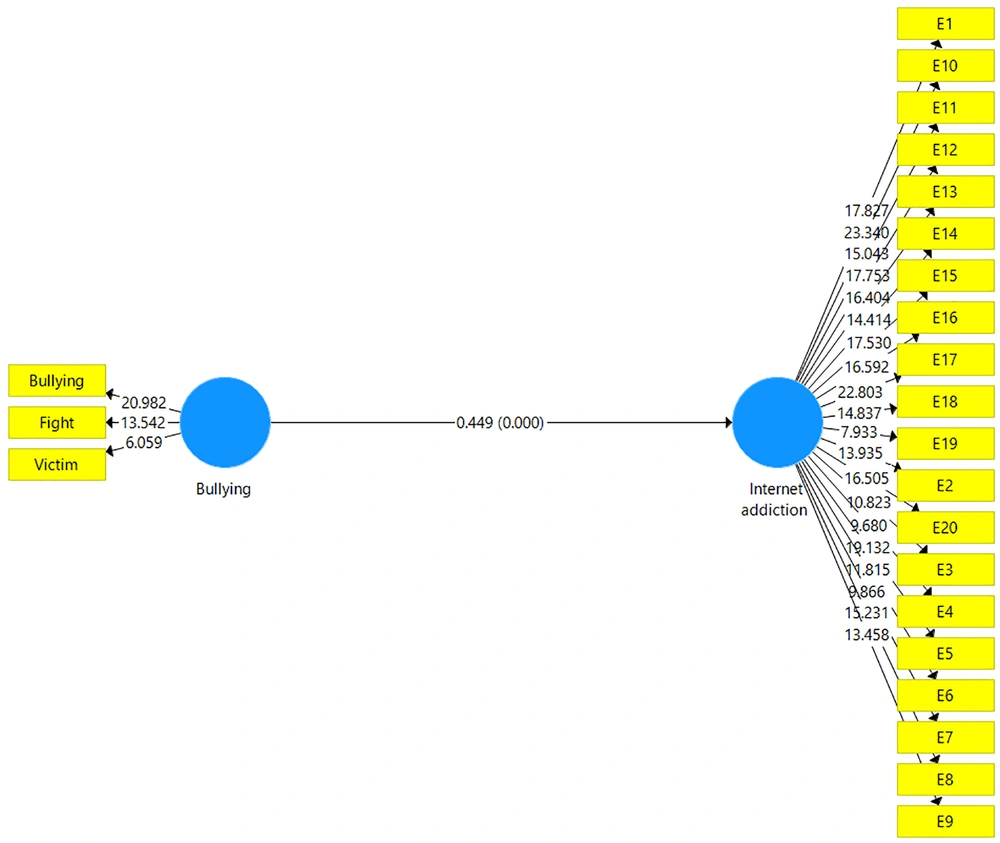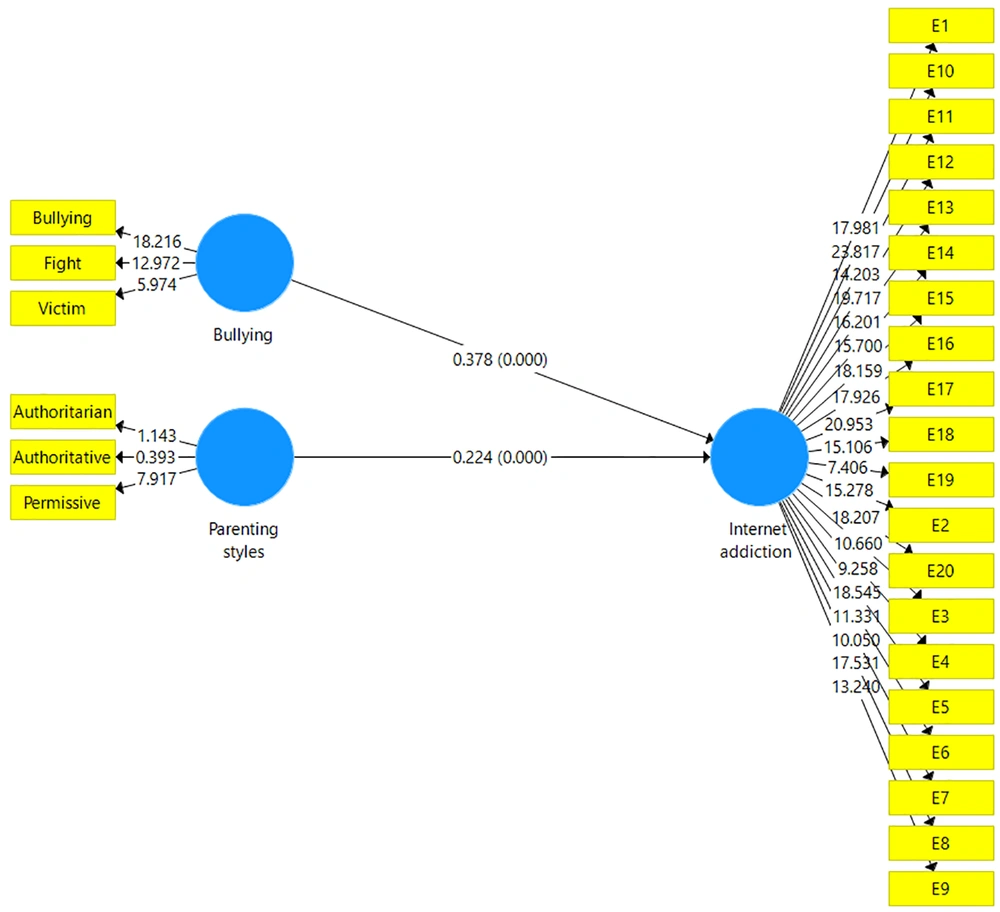1. Background
Using the internet for social interaction and instruction has increased among adolescent students. Both adolescents and children may become heavy internet users and become addicted to it, accompanied by an uncontrollable motivation for its use (1) and spending considerable time on it (2). Internet addiction causes problems such as eating disorders (3), low self-esteem (4), depression (5), and anxiety (6). It has destructive effects on the health of adolescent students, such as sleep disorders, anxiety, and depression (7). Many studies have examined the risk factors of internet addiction. Apart from factors such as personality-related characteristics and impulsive behavior, the impact of the family on internet addiction has been greatly emphasized in some studies (8). For example, negative parenting styles, including violent parenting, increase adolescents' internet addiction risk (9). Parenting styles are the parents' attitudes and behaviors toward their children and using specific methods to educate them (10). According to Baumrind and Schaefer's theory, there are three parenting styles: Permissive, authoritarian, and authoritative (11). The permissive parenting style is high in acceptance and responsiveness but low in demand and control (12). According to the literature, the children of parents with a permissive parenting style have more online relationships and internet addiction (13). Authoritarian parents set rules, guidelines, and precise boundaries within their family. This parenting style is in high demand, has low responsiveness, and is characterized by strict control over the children's independence (14). Some studies indicate that an authoritarian parenting style leads to addictive internet use in children (15). Meanwhile, the authoritative parenting style, while respecting the children's personality, instills social values and enjoys a high degree of intimacy with children (16). Yaffe and Seroussi (17) showed that an authoritative parenting style fosters intimacy between children and parents, thereby causing them to have better relationships with each other and spend less time on the internet.
Research suggests that harsh parenting style, directly and indirectly, affects internet addiction. Besides parenting styles, bullying is a variable that can directly or indirectly impact internet addiction. Bullying is a deliberate and aggressive harassing behavior repeated by a person or persons at a particular time when power is unequally distributed (18). Indeed, bullying is a complex behavior requiring a precise understanding of the social dynamics of peer groups and schools (19). In general, bullying in scientific and educational texts is defined as repeated aggressive behaviors aimed at harming the person with less power and has three characteristics: Voluntary behavior, power inequality, and repetition of action (20).
Strong research evidence suggests that children's exposure to maltreatment significantly contributes to the risk of being involved in bullying behavior as a victim or perpetrator (21). Adolescents involved in bullying behavior as either victims or perpetrators often exhibit fewer social connections, are more heavy users of the internet and tend to establish relationships in cyberspace rather than the real world to achieve a sense of belonging. This may contribute to their addictive behavior on the internet (22). Studies have revealed that parenting styles are associated with bullying behaviors (23-25). In the authoritarian parenting style, children receive little love and attention from their parents, and during childhood, they constantly experience more aggression, punishment, and blame than their peers. These children experience significant anger, hatred, and low creativity and self-esteem due to unsatisfied emotional needs (26). In other words, people who suffered considerable violence as children and were constantly bullied attempt to compensate for these behaviors on others and society in adulthood, which can manifest itself as various bullying behaviors, such as delinquency, theft, obscenity, and being beaten (24). In the permissive parenting style, if the relationship between the parent and the child is of poor quality (e.g., in cases where the parents use incorrect parenting methods or have unstable supervision and neglect the child's behavior), adolescents may show norm-breaking and antisocial behaviors (27). Indeed, these people, who never experienced any behavioral restrictions as children and did whatever they liked, cannot bear hearing no when they enter the community upon adulthood and do everything to make their wishes come true, which forms bullying behavior (23). Therefore, virtual and non-face-to-face interactions, due to the possibility of unrestricted entry and exit and the absence of direct physical harm, free people from the immediate anxiety caused by their behavior. As a result, cyberspace is a safer place for people who are highly anxious about the annoying consequences of their behavior. The widespread prevalence of internet addiction among students and their numerous problems, the importance of parenting styles and bullying, and the role of each variable in internet addiction led the researcher to conduct this study. Research on the relationship between these variables and internet addiction in female students can be the basis for designing and administering intervention programs to promote healthy behaviors in these students. Therefore, the present research aimed to investigate the specific and common effects of parenting styles and bullying on internet addiction
2. Objectives
An attempt has been made to examine the specific and common effects of coping styles and bullying on the internet addiction of female high-school students.
3. Materials and Methods
3.1. Participants
In this correlational study, the population consisted of all female high-school students in Yasouj (Iran) in the academic year 2020-21. The sample consisted of 357 female high-school students selected according to convenience sampling. Due to the COVID-19 pandemic, the questionnaires were distributed and completed on WhatsApp. As some questionnaires were expected to be incomplete or problematic, initially, 400 questionnaires were distributed and collected. After reviewing the questionnaires, incomplete questionnaires were discarded, and finally, the data from 357 questionnaires were analyzed.
3.2. Ethical Considerations
All ethical principles were meticulously followed. The participants were briefed about the study's objectives and its different phases. They were also assured their information would remain confidential.
3.3. Instruments
3.3.1. Internet Addiction Questionnaire
This questionnaire, developed by Yang and Tung (28), comprises 20 items on a 5-point Likert scale (from strongly disagree to strongly agree). The scores range from 20 to 100. A higher score suggests higher internet addiction. In Yang and Tung's study, the internal validity of the questionnaire was higher than 0.92, and the test-retest validity was significant. Widyanto and McMurran (29) reported its convergent validity to be very high. In addition, the reliability of the questionnaire was 0.88, using Cronbach's alpha, and its reliability was 0.79 using the test-retest method (29). In our study, its content validity was confirmed by several professors at the Department of Psychology and Educational Sciences of Yasouj University, and a Cronbach's alpha of 0.93 was obtained.
3.3.2. Baumrind's Parenting Styles and Dimensions Questionnaire
The Parenting Styles and Dimensions Questionnaire (PSDQ) was developed by Baumrind (1991). It measures three styles: Authoritarian, authoritative, and permissive. This questionnaire has 30 items, whose scores are determined on a 5-point Likert scale. Buri (30) obtained the reliability of the authoritative, authoritarian, and permissive styles as 0.78, 0.86, and 0.81, respectively. The internal consistency coefficients of each dimension were reported by Buri (30) as 0.75, 0.85, and 0.82 for permissive, authoritarian, and authoritative mothers, as well as 0.74, 0.87, and 0.85 for permissive, authoritarian, and authoritative fathers, respectively. Buri also reported the diagnostic validity of the questionnaire to be favorable (31). In the present study, its content validity was confirmed by several professors at the Department of Psychology and Educational Sciences of Yasouj University. In addition, Cronbach's alpha was 0.79, 0.82, and 0.83 for permissive, authoritarian, and authoritative parenting styles, respectively, and 0.76 for the entire questionnaire.
3.3.3. The Illinois Bully Scale
To measure the students' bullying, the Illinois Bully Scale was administered. It comprises 18 items and three dimensions of bullying behavior, fighting, and victimization by peers. It comprises nine items for bullying behavior, four items related to victimization, and five items on fighting. The scores on a Likert scale range from 1 (never) to 5 (always). Espelage and Holt (32) used factor analysis and convergent and divergent validity to evaluate the scale's validity. Cronbach's alpha was used to check the scale's reliability, and the coefficient of each subscale of bullying behavior, fighting, and victimization was 0.87, 0.79, and 0.70, respectively. In a study by Chalmeh (33), the reliability of the questionnaire was obtained using Cronbach's alpha and was above 0.70. In the present study, its content validity was confirmed by several professors at the Department of Psychology and Educational Sciences of Yasouj University. In addition, Cronbach's alpha was 0.71.
3.4. Statistical Analyses
The relationships between the variables were investigated using path analysis and structural equation modeling in SmartPLS software.
4. Results
In this section, the descriptive and then inferential findings of the research objectives are reviewed. Table 1 presents the mean, standard deviation (SD), and the lowest and highest scores of the research variables. The highest mean belongs to the authoritative parenting style (32.66), and the highest standard deviation belongs to the authoritarian parenting style (7.06). Table 2 shows the correlation matrix (zero-order) of the research variables.
| Variables | Minimum | Maximum | Mean ± SD |
|---|---|---|---|
| Permissive | 0 | 34 | 16.1 ± 6.40 |
| Authoritarian | 0 | 35 | 15.27 ± 7.06 |
| Authoritative | 13 | 40 | 32.26 ± 4.40 |
| Bullying behavior | 9 | 34 | 10.11 ± 2.70 |
| Victimization | 5 | 21 | 6.33 ± 2.28 |
| Fighting | 4 | 19 | 7.09 ± 3.26 |
The Mean, Standard Deviation (SD), Minimum, and Maximum Scores of the Research Variables
| Variables | 1 | 2 | 3 | 4 | 5 | 6 | 7 |
|---|---|---|---|---|---|---|---|
| 1. Permissive | 1 | ||||||
| 2. Authoritarian | 0.05 | 1 | |||||
| 3. Authoritative | 0.20** | -0.27** | 1 | ||||
| 4. Bullying behavior | 0.19** | 0.11** | -0.22** | 1 | |||
| 5. Victimization | 0.14** | 0.02 | -0.08 | 0.39** | 1 | ||
| 6. Fighting | 0.24** | 0.01 | 0.02 | 0.35** | 0.18** | 1 | |
| 7. Internet addiction | 0.31** | 0.07 | 0.07 | 0.35** | 0.21** | 0.37** | 1 |
The Zero-Order Correlation Matrix of the Variables a
Based on Table 2, the variables in question correlate with internet addiction, and the coefficients range from 0.21 to 0.37.
Structural equation modeling was used in SmartPLS to determine the contribution of each variable of parenting styles and bullying in predicting internet addiction.
Figures 1 to 3 show the structural equation model to determine each predictor's specific and common effect (parenting style and bullying) on the criterion variable (internet addiction).
According to the fitted model (Figures 1 - 3), the standardized regression coefficient of the specific effect of parenting styles and bullying on internet addiction is 0.35 and 0.45, respectively. Besides, the standardized regression coefficient of the common effect of bullying and parenting styles on internet addiction is 0.38 and 0.22, respectively. The explained variance (R2) of internet addiction for the specific effect of each variable of parenting styles and bullying is 0.12 and 0.20, respectively. Moreover, the explained variance (R2) of internet addiction for the common effect of bullying and parenting styles is 0.25.
Table 3 shows that all structural model fit indices, such as SRMR, d-ULS, d-G, and NFI for the models presented in Figures 1 - 3, are within the normal and acceptable range.
| Variables | R2 | SRMR (SRMR ≤ 0.08) | d-ULS (0.95 ≥ d-ULS) | d-G (d-(ULS ≤ 0.95) | NFI (NFI ≥ 0.90) | Chi-square |
|---|---|---|---|---|---|---|
| Parenting styles on internet addiction | 0.12 | 0.06 | 0.88 | 0.63 | 0.78 | 721.62 |
| Bullying on internet addiction | 0.20 | 0.06 | 0.80 | 0.38 | 0.78 | 754.38 |
| Bullying and parenting styles on internet addiction | 0.25 | 0.07 | 0.75 | 0.47 | 0.74 | 949.44 |
Summary of the Results of the Fit Indices of the Variables
Table 4 shows Cronbach's reliability coefficients and the composite and average variance extracted (AVE) of the research variables. Since all the calculated coefficients are within their respective ranges, the appropriateness of the reliability and convergent validity of the external relations of the model can be confirmed.
| Variables | Cronbach's Alpha (Alpha ≥ 0.70) | Composite Reliability (Alpha ≥ 0.70) | The Average Variance Extracted (AVE ≥ 0.50) |
|---|---|---|---|
| Internet addiction | 0.93 | 0.94 | 0.53 |
| Parenting styles | 0.76 | 0.82 | 0.61 |
| Bullying | 0.71 | 0.77 | 0.53 |
Reliability Coefficients and Average Variance Extracted (AVE)
Another model fit index is the Stone-Geiser Q2 value. As reported in Table 5, Q2 values for bullying constructs, internet addiction, and parenting styles are 0.14, 0.32, and 0.15, respectively, indicating the good and strong fit of the structural model.
| Research Construct | SSO | SSE | Q2(=1-SSE/SSO) |
|---|---|---|---|
| Bullying | 1071.00 | 992.76 | 0.14 |
| Internet addiction | 7140.00 | 4861.54 | 0.32 |
| Parenting styles | 4998.00 | 4271.47 | 0.15 |
Q2 Criterion for the Endogenous Constructs
5. Discussion
The present study investigated the specific and common effects of parenting styles and bullying on female high-school students' internet addiction. The results showed that parenting styles and bullying separately have a strong and significant effect on internet addiction. In addition, both variables could explain and predict internet addiction. This finding is consistent with numerous studies (8, 15, 24, 25, 34). For instance, Lo et al. (15) showed that bullying, parents' behavioral style, and harsh or permissive behavior significantly affect children's internet addiction. They found that family support and bullying explain 36% and 25% of the effect of harsh discipline and misbehavior on internet addiction, respectively (15).
When caregivers maltreat children or adolescents, those maltreated likely feel insecure toward their caregivers. They may even go as far as perceiving the world as unsafe and developing a sense of hostility which can, in turn, cause problems in their relationships (35). Children and adolescents who receive inappropriate parenting styles may develop violent attitudes, which, in turn, might result in welcoming more violence and becoming more bullying in their interpersonal relationships (22). Then, their bullying behavior might increase the risk of using the internet to build relationships with others and/or escape from the stressful circumstances they might encounter in society. The anonymous nature of the internet is very likely to create a relatively safe atmosphere for bullying adolescents to develop new identities and satisfy their social needs. In other words, adolescents, especially females, may consider cyberspace a safe atmosphere where they can express their feelings. The individual may find online play and interaction an effective means of developing a better feeling about communication and competency. In general, the theory of compensatory use of the internet (36) can be cited to explain these results. This theory argues that addiction concerns the interaction between the individual, culture, and environment. Furthermore, internet addiction is a negative coping strategy based on which negative life situations (such as permissive parenting style and bullying) cause a person to turn to the Internet to reduce negative feelings.
The effects of bullying and parenting styles on internet addiction revealed that for adolescents experiencing an inappropriate parenting style, early identification, and intervention may prevent bullying and, as a result, diminish the risk of internet addiction. Limiting the time adolescents spend on the Internet might be an important action to avoid internet addiction (37).
The findings of this study indicated that parenting style might exacerbate internet addiction. Experts who deal with adolescents with internet addiction disorder need to consider their family's role and monitor the parenting styles these individuals are exposed to at home. Therefore, a purposive intervention that addresses underlying family disorders may be more effective in enabling these adolescents to cope with internet addiction than reducing internet use per se. Besides, experts dealing with adolescents with a child abuse and bullying history should consider and evaluate their online behaviors simply because the victims may use the internet to acquire a sense of belonging, emotional renewal, and psychological satisfaction. It must be kept in mind that excessive reliance on the internet as a means of meeting these psychological needs may increase their risk of internet addiction. In summary, parental supervision should be a primary factor used to and/or treat internet addiction and other related problems.
5.1. Study Limitations
This study had some limitations. First, the design was correlational, so a causal relationship between parenting style and internet addiction could not be inferred. Second, since the convenience sampling method was used due to the outbreak of COVID-19, extreme caution should be exercised in generalizing the results. Moreover, the data are based on adolescent self-assessment reports and are, therefore, subject to reporting bias due to social desirability.
5.2. Conclusions
This study demonstrated the general and specific effects of parenting styles and bullying on internet addiction. The findings provide further evidence that social and familial factors are crucial in understanding internet addiction. Therefore, preventive and intervention strategies for familial and social harms and correcting parents' behavior are essential. Although the present research focused on bullying and parenting styles that impact internet addiction, teachers and other support networks that can neutralize the impact of violent parenting and abuse on internet addiction should still be considered. According to the mentioned limitations and the findings of this study, future research projects should explore the relationship between these variables in other populations and age groups so that the association between the studied variables can be clarified. In addition, future studies should use experimental or causal-comparative designs to determine cause-effect relationships between the variables.



